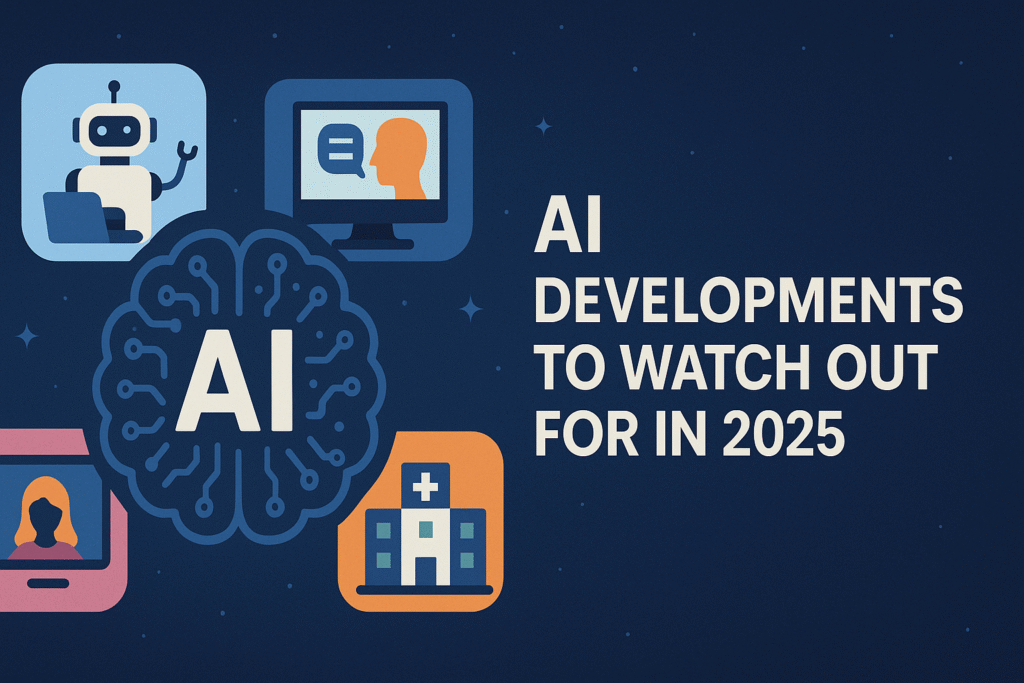Introduction
Artificial Intelligence (AI) has come a long way, from being a buzzword in tech circles to a daily utility embedded in everything from emails to electric cars. In just the past couple of years, we’ve seen AI go from basic chatbot assistants to mind-blowing generative models that can create entire films, songs, and reports with just a prompt.
With this rapid growth, staying ahead of the curve isn’t just about being trendy, it’s about staying relevant. Whether you’re a business leader, developer, content creator, or an average user, understanding where AI is headed in 2025 will help you make smarter decisions.
In this blog, we’ll break down the biggest AI developments to watch out for in 2025. These innovations are set to transform industries, reframe how we work, and even impact our day-to-day lives. Let’s dive in.
Agentic AI and Autonomous Systems
One of the most exciting developments on the horizon is Agentic AI, AI systems that don’t just follow commands but take initiative to get things done. Think of it as going from a calculator to a digital personal assistant that can independently decide how to solve your problems.
Imagine bots that manage your calendar, plan your meetings, and even order groceries based on your routine, without being told every single step. In 2025, we’ll see more sophisticated agentic systems both at home and in the workplace.
Applications include:
- Task bots for automating workflows.
- Smart home assistants that adapt to user behavior.
- Autonomous cleaning bots and workplace helpers.
According to a 2024 report by Axios, there’s a strong prediction that home-cleaning and workplace robots with agentic capabilities will surge in popularity. These bots won’t just clean when told, they’ll detect when a space needs cleaning and handle it autonomously.
In short, Agentic AI will bring us closer to truly self-directed systems, something the industry has been inching toward for years.
AI in the Workplace

If 2023 and 2024 were about AI entering the workplace, 2025 will be about it becoming indispensable. Businesses are no longer asking if they should use AI, they’re figuring out how fast they can implement it.
Key transformations in 2025:
- Automation of routine tasks: AI will handle meeting notes, generate content drafts, summarize research, and even send follow-up emails.
- Employee upskilling: Companies like Uber are already investing in internal AI literacy programs, equipping teams to work with AI rather than fear it.
- Popular tools on the rise: Expect even broader use of Microsoft Copilot, ChatGPT, Claude, and other AI copilots.
Reports from LinkedIn show an increasing trend in job listings requiring AI familiarity, even for non-tech roles. Hiring priorities are shifting. Job roles are evolving. And employees who embrace AI as a productivity partner will have a serious edge.
AI-Powered Creativity

Creative fields are often considered immune to automation, but AI is proving otherwise, in a good way. Instead of replacing creators, it’s becoming their co-pilot.
In 2025, AI will impact creative industries by:
- Streamlining production workflows: From automated editing to real-time VFX rendering.
- Boosting storytelling capabilities: AI can help writers build narrative arcs or even generate scripts based on prompts.
- Democratizing content creation: Independent filmmakers and artists now have access to tools that were once limited to big studios.
Take Netflix for example, it’s using AI not just for recommendations, but also to improve film quality and reduce post-production costs. From lighting adjustments to noise reduction, AI handles the technical while creators focus on the storytelling.
This opens up a whole new world for creators, where imagination is the only limit, not budget or bandwidth.
Multimodal and Generative AI Advancements

If 2024 was the year of text-based generative AI, 2025 is the year of multimodal AI, models that can understand and generate text, images, audio, and video together.
So what’s changing?
- Multimodal AI can process diverse inputs, like generating a video based on a written script and voice sample.
- Generative AI will move beyond text to create realistic images, synthetic voices, lifelike avatars, and interactive simulations.
Real-world applications:
- Customer service with AI avatars who speak and respond in real-time
- Education tools with video lectures created on-demand
- Healthcare simulations for doctor training and patient interaction
New models to keep an eye on:
- GPT-5 (rumored for mid-2025)
- Gemini advancements from Google
- Claude next-gen from Anthropic
These models are expected to break new ground in reasoning, memory, and interactivity, paving the way for highly personalized user experiences.
AI for Cybersecurity and Deepfake Detection

As AI capabilities grow, so do the risks, especially in misinformation and digital fraud. Deepfakes are getting harder to spot, and bad actors are using AI tools to generate convincing scams.
The 2025 AI defense playbook:
- Deepfake detection tools like Vastav AI, India’s first AI-powered deepfake scanner, are gaining traction globally.
- AI in cybersecurity: Real-time threat detection, automated responses, and anomaly recognition are becoming standard.
- Government and enterprise security: AI will play a key role in infrastructure protection, data governance, and cyber warfare.
Expect regulatory bodies to push for stricter frameworks, especially around identity verification and media authenticity.
AI in the Public Sector & Sustainability

AI isn’t just for businesses, it’s becoming a key tool for public sector transformation and sustainability efforts.
How AI will support public good in 2025:
- Healthcare: Predictive diagnostics, automated patient support
- Education: AI tutors, curriculum design, rural outreach
- Traffic and agriculture: Real-time traffic flow adjustments and precision farming tools
When it comes to climate change, AI will assist with:
- Disaster response planning
- Weather forecasting
- Energy optimization
According to Science Direct, multimodal AI models are already being tested for integrated use in government systems, where a single AI model can analyze weather reports, satellite imagery, and emergency calls simultaneously.
The goal? Smarter decisions, faster response, and a greener planet.
Conclusion
AI in 2025 isn’t just an extension of 2024, it’s an evolution. From agentic bots that act on their own to creative copilots that help us produce art, the AI landscape is more dynamic than ever.
Here’s a quick recap of what to keep an eye on:
- Agentic AI becoming more autonomous in homes and offices
- Workplace automation and AI literacy becoming standard
- Generative and multimodal AI pushing creative and functional boundaries
- Cybersecurity AI rising to combat deepfakes and misinformation
- Public sector applications of AI scaling across healthcare, education, and sustainability
But as we ride this wave, it’s crucial to stay adaptive, informed, and above all, ethical. The power of AI lies not just in what it can do, but in how responsibly we use it.
2025 is shaping up to be a defining year. The question is, are you ready?





